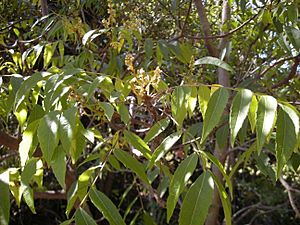Jagera pseudorhus facts for kids
Quick facts for kids Jagera pseudorhus |
|
|---|---|
 |
|
| Jagera pseudorhus - leaves and flowers | |
| Scientific classification | |
| Genus: |
Jagera
|
| Species: |
pseudorhus
|
| Synonyms | |
|
|
The Foambark tree, also known as Jagera pseudorhus, is a fascinating plant found in the rainforests of eastern Australia and New Guinea. It gets its unique name because its bark can create a foamy lather, especially after heavy rain! This happens because the bark contains natural substances called saponins, which are like natural soap.
This tree is part of the Sapindaceae family, which also includes plants like lychees and maples. People sometimes call it "ferntop" or "pink tamarind" too.
Contents
Where Foambark Trees Grow
Foambark trees love warm, wet places. In Australia, you can find them growing naturally from the Manning River in New South Wales all the way up to the Bloomfield River in far north Queensland. They are also very common across New Guinea.
These trees thrive in tropical and subtropical rainforests. They also grow in areas called monsoon forests and gallery forests, which are forests found along rivers. They prefer rich, fertile soils.
Different Types of Foambark Trees
Scientists have identified two main types, or varieties, of the foambark tree:
- Jagera pseudorhus var. integerrima – This type is only found in the Atherton Tableland in Queensland, Australia.
- Jagera pseudorhus var. pseudorhus – This type grows in New South Wales, Queensland, and New Guinea.
What Foambark Trees Look Like
Foambark trees can grow quite tall, reaching up to 30 meters (about 100 feet) high. Their main trunk can be as wide as 50 centimeters (about 20 inches). When they are grown in gardens, they are usually a bit smaller.
The bark of the tree is smooth and grey. It often has raised lines that go across the trunk. Larger trees might have a wide, flared base.
Leaves, Flowers, and Fruit
The leaves of the foambark tree grow in an interesting way. They are called "pinnate," meaning they have many smaller leaflets arranged along a central stem, like a feather. Each leaf can have between eight and twenty-six leaflets. These leaflets are usually 4 to 6 centimeters long. They have small teeth along their edges and a pointed tip. The undersides of the leaves and the young branches are often a bit hairy.
Yellow-brown flowers appear on the tree from March to May. These flowers grow in clusters called panicles. After the flowers, the tree produces fruit between August and November. The fruit is a hairy capsule with three sections, each about 18 millimeters long. When they are young, the capsules are a pretty violet-pink color, but they turn brown as they ripen. Each section of the capsule holds one seed, which is covered in a fleshy coating called an aril.
It's good to be careful when touching the fruit capsules. The tiny hairs on them can sometimes make your skin feel itchy!
Animal Visitors
Some Australian birds love to eat the fruit of the foambark tree. These include the colorful Australian king parrot and the green catbird. If you want to grow a foambark tree, it's not too hard to get new plants from fresh seeds.
Uses of the Foambark Tree
Because of its attractive shape, the foambark tree is often planted as an ornamental tree in gardens and parks.
Indigenous Australians have traditionally used the foambark tree in clever ways. They would crush the bark or leaves to create a foam. This foam was used to help catch fish by making them easier to gather. The natural foam from the bark was also used as a kind of soap for washing.
See also
 In Spanish: Corteza de jabón para niños
In Spanish: Corteza de jabón para niños

